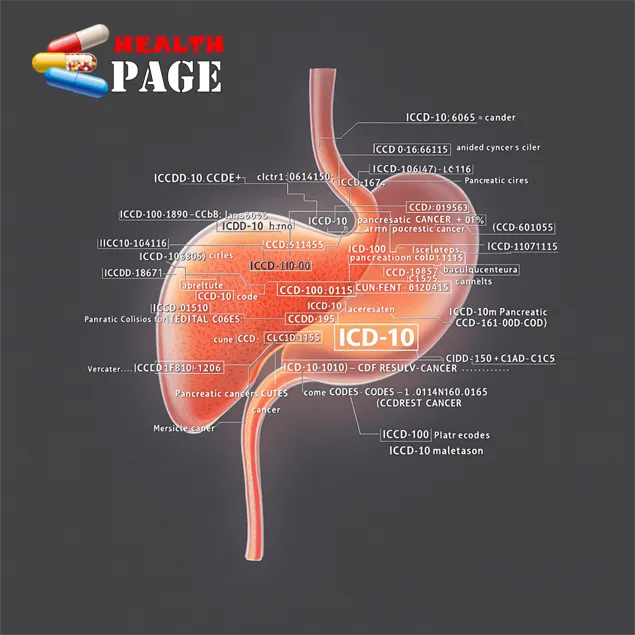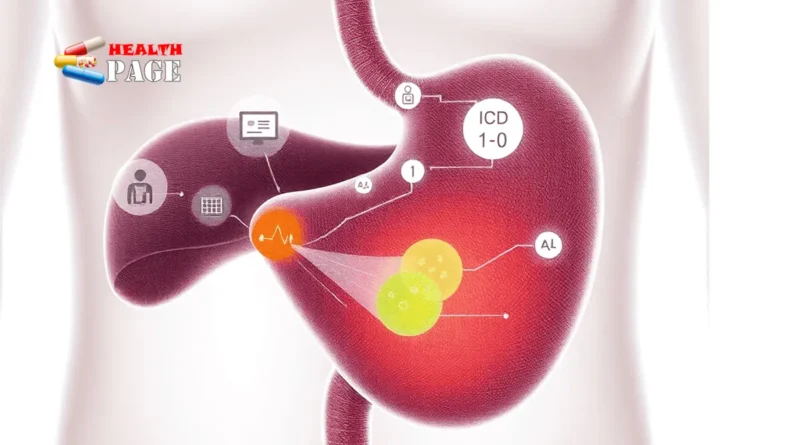5 Breakthrough Insights Into Pancreatic Cancer ICD 10 for Better Diagnosis
Pancreatic cancer is one of the most difficult challenges in medicine, affecting thousands of lives each year. The pancreatic cancer ICD 10 classification system is an important tool in the fight against this devastating disease.
Why Understanding Pancreatic Cancer Matters
Understanding pancreatic cancer requires precision at every stage – from identifying initial symptoms to developing treatment plans. This aggressive disease often takes lives quickly, with a five-year survival rate of less than 10%. Behind these numbers are real people, families, and communities who are deeply affected by each diagnosis.
How ICD-10 Codes Help in Managing Pancreatic Cancer
The International Classification of Diseases (ICD-10) brings order to this complex medical field. These standardized codes serve multiple purposes:
- Tracking disease patterns accurately
- Streamlining medical billing processes
- Informing treatment decisions
- Supporting research initiatives
- Improving communication among healthcare providers
For patients with pancreatic cancer, correct ICD-10 coding can make a significant difference between receiving prompt intervention or experiencing delays in treatment. Each code provides specific information about:
The precise location of the tumor
The progression of the disease
Unique characteristics that impact treatment options
Healthcare providers depend on these codes to make well-informed choices regarding patient care. When the right code is used, appropriate treatments can be administered. On the other hand, if coding errors occur, it may lead to postponements in interventions or unsuitable therapeutic methods.
The Evolving Role of ICD-10 in Pancreatic Cancer Management
As medical science continues to evolve, so does the connection between accurate diagnosis and successful treatment outcomes. The ICD-10 system adapts accordingly by integrating new knowledge and supporting healthcare professionals in their goal to enhance patient results.
1. Vague Symptoms: The Silent Challenge
Pancreatic cancer symptoms present a unique diagnostic puzzle for healthcare providers. The subtle nature of these symptoms creates a complex web of challenges in early detection and accurate ICD-10 coding.
Common Early Warning Signs:
- Unexplained weight loss (R63.4)
- Upper abdominal discomfort (R10.84)
- Mid-back pain (M54.6)
- Loss of appetite (R63.0)
- New-onset diabetes (E13.9)
These non-specific symptoms mirror many benign conditions, leading patients to dismiss them as temporary health issues. A patient might attribute weight loss to stress or back pain to poor posture, delaying crucial medical intervention.
Healthcare professionals face intricate coding decisions when documenting these symptoms. The ICD-10 system requires precise documentation of each symptom, yet the interconnected nature of pancreatic cancer manifestations creates coding complexities.
Coding Challenges in Symptom Documentation:
- Multiple symptoms requiring separate codes
- Temporal relationships between symptoms
- Varying symptom severity levels
- Overlapping manifestations with other conditions
The coding landscape becomes particularly challenging when symptoms evolve. A patient’s initial upper abdominal discomfort (R10.84) might progress to jaundice (R17), requiring additional code assignments and documentation updates.
Medical professionals must navigate the delicate balance between comprehensive symptom coding and avoiding redundancy. Each symptom requires careful evaluation to determine its relationship to potential pancreatic cancer, impacting both coding accuracy and diagnostic timing.

Critical Coding Considerations:
- Primary vs. secondary symptoms
- Symptom progression patterns
- Related condition documentation
- Diagnostic test correlation
Healthcare providers often implement specialized documentation protocols to capture subtle symptom changes. These protocols help bridge the gap between vague patient descriptions and precise ICD-10 coding requirements, enhancing diagnostic accuracy and treatment planning.
Understanding the full spectrum of pancreatic cancer symptoms is crucial for effective diagnosis and treatment.
2. Tumor Site Documentation: A Key to Accurate Coding
Precise tumor site documentation is crucial for diagnosing and treating pancreatic cancer. The ICD-10 system has specific codes for different parts of the pancreas, which helps create detailed medical records and plan targeted treatments.
Primary ICD-10 Codes for Pancreatic Cancer Sites:
- C25.0: Head of pancreas
- C25.1: Body of pancreas
- C25.2: Tail of pancreas
- C25.3: Pancreatic duct
- C25.4: Endocrine pancreas
- C25.7: Other parts of pancreas
- C25.8: Overlapping sites
- C25.9: Unspecified sites
Each code corresponds to a specific area in the pancreas, influencing surgical methods and treatment plans. For instance, a tumor in the head of the pancreas (C25.0) may require different surgical techniques compared to one in the tail (C25.2).
Documentation Requirements for Accurate Coding:
- Specific anatomical location
- Size of tumor
- Extent of spread
- Involvement of surrounding structures
- Presence of metastasis
Healthcare providers must document these details precisely. Even one missing piece of information can lead to incorrect coding, which can affect:
- Treatment planning
- Insurance coverage
- Clinical research data
- Patient outcomes tracking
The connection between tumor location and treatment success makes accurate documentation vital. Research indicates that tumors in various regions of the pancreas respond differently to therapies. Tumors located in the head of the pancreas often show earlier symptoms due to bile duct blockage.
Advanced imaging techniques help identify exact tumor locations, and these findings should be reflected in precise ICD-10 codes. Medical teams utilize these codes for:
- Planning surgical approaches
- Determining radiation therapy fields
- Selecting chemotherapy protocols
- Monitoring treatment responses
The quality of patient care is directly influenced by documentation accuracy. Comprehensive records enable medical teams to track disease progression and modify treatments as needed.
3. Clinical Distinctions Matter: Beyond the Numbers
The complexity of pancreatic cancer coding reveals striking disparities in oncology documentation practices. Different cancer types require varying levels of detail in their ICD-10 classifications.
Coding Complexity Variations:
- Prostate cancer uses a limited set of codes
- Breast cancer employs extensive coding options for staging
- Pancreatic cancer demands precise anatomical location specifications
Pancreatic cancer’s unique coding requirements stem from its anatomical complexity. The pancreas’s intricate structure necessitates detailed documentation of tumor locations and characteristics.
Critical Clinical Information for Accurate Coding:
- Tumor size measurements
- Involvement of surrounding tissues
- Presence of metastasis
- Histological findings
- Treatment response indicators
Medical professionals must integrate these clinical details with appropriate ICD-10 codes. This integration helps create a comprehensive patient profile for targeted treatment strategies.
Real-world Application Example:
A patient presents with a 2.5cm tumor in the pancreatic head. The clinical assessment reveals local lymph node involvement. This information combines with ICD-10 code C25.0 to guide surgical planning and adjuvant therapy decisions.
The synergy between clinical data and ICD-10 codes shapes treatment pathways. Healthcare providers use this combined information to:
- Select appropriate surgical approaches
- Determine radiation therapy fields
- Choose targeted chemotherapy protocols
- Monitor treatment effectiveness
- Plan follow-up care schedules
Advanced diagnostic tools enhance the precision of clinical distinctions. Modern imaging techniques provide detailed visualizations that support accurate ICD-10 code assignment.
Key Diagnostic Tools:
- High-resolution CT scans
- Endoscopic ultrasound
- MRI with contrast
- PET-CT imaging
- Molecular profiling results
This multi-faceted approach to diagnosis strengthens the foundation for personalized treatment plans. The combination of detailed clinical information and precise ICD-10 coding creates a robust framework for patient care.
4. Integrating Early Detection Strategies with ICD-10 Codes
Early detection remains a critical challenge in managing pancreatic cancer ICD 10 cases. Medical professionals now employ several promising screening methods for high-risk patients:
- Endoscopic Ultrasound (EUS) – Detects small lesions with ICD-10 code Z12.89 for special screening examination
- Magnetic Resonance Imaging (MRI) – Identifies pancreatic abnormalities, coded under Z01.89
- Blood-based Biomarker Tests – Tracks specific proteins linked to pancreatic cancer development
The integration of clinical data with ICD-10 codes creates a robust framework for early detection:
1. Risk Assessment Protocols
- Family history tracking (Z80.0)
- Genetic mutation screening (Z13.71)
- Chronic pancreatitis monitoring (K86.1)
2. Symptom Documentation
- Weight loss patterns (R63.4)
- Abdominal pain characteristics (R10.9)
- Jaundice onset (R17)
Healthcare systems now utilize advanced algorithms to analyze ICD-10 coded data patterns. These systems flag potential pancreatic cancer cases based on:
“Combination of specific symptoms, risk factors, and diagnostic test results creates a comprehensive early warning system”
The integration of molecular diagnostics with ICD-10 coding enhances detection accuracy:
- CA 19-9 tumor marker levels
- Genetic mutation presence
- Inflammatory marker patterns
Electronic Health Records (EHRs) play a vital role by:
- Tracking symptom progression through ICD-10 codes
- Identifying high-risk patient populations
- Automating screening recommendations
- Monitoring diagnostic testing patterns
Machine learning algorithms analyze these coded data points to predict pancreatic cancer risk levels. This technological advancement helps medical professionals identify potential cases earlier than traditional methods allow.
Research institutions use this integrated approach to:
- Study population-level risk factors
- Develop targeted screening protocols
- Evaluate detection strategy effectiveness
- Refine diagnostic criteria
5. The Future of Pancreatic Cancer Diagnosis: Precision Medicine and Beyond
The way we diagnose pancreatic cancer is about to change dramatically thanks to innovative technologies. Artificial Intelligence (AI) algorithms are now able to analyze medical images with incredible precision, spotting small pancreatic issues that even the most trained eyes might overlook.
Revolutionary Approaches to Detection
One of the most exciting developments in pancreatic cancer detection is the use of liquid biopsy technology. This groundbreaking method offers a less invasive way to identify the disease by detecting circulating tumor DNA in blood samples. With this technique, doctors can potentially diagnose pancreatic cancer at an earlier stage and monitor treatment progress more effectively.
Key Emerging Technologies:
- Advanced imaging techniques that specifically target molecular structures
- Diagnostic platforms powered by AI
- Systems that integrate multiple types of biological data (known as multi-omics)
- Devices that allow for real-time monitoring of tumors
- Tools for personalized genetic screening
Tailoring Treatment with Precision Medicine
Precision medicine is an approach that customizes treatment plans based on each patient’s unique genetic makeup and tumor characteristics. By combining International Classification of Diseases (ICD-10) codes with genetic profiling data, healthcare providers can create comprehensive profiles for patients, leading to more effective treatments.
Modern diagnostic platforms are now incorporating various advanced techniques:
- Molecular Profiling: Identifying specific genetic mutations present in the tumor
- Biomarker Analysis: Measuring unique indicators associated with the disease
- Immunological Assessment: Evaluating how the immune system responds to the cancer
- Metabolomic Studies: Analyzing patterns in cellular metabolism
These innovations in technology go hand-in-hand with improved capabilities in ICD-10 coding. Healthcare professionals can now document specific genetic markers and molecular subtypes using these codes, resulting in more accurate diagnoses and treatment plans.
Combining Data for Smarter Diagnostics
Research institutions around the world are working on developing intelligent diagnostic tools that bring together multiple sources of information:
“The combination of precision medicine and ICD-10 coding creates a powerful framework for personalized cancer care.”
Machine learning algorithms are being utilized to analyze large volumes of patient data and identify patterns that can predict how individuals will respond to different treatments. This ability to make predictions based on data will assist doctors in selecting the most suitable therapeutic approaches for their patients.
The introduction of digital pathology platforms allows for remote consultations with experts and automated analysis of tissue samples. These systems have the potential to speed up the diagnostic process while maintaining accuracy through standardized assessment protocols.
Conclusion
The journey through these 5 Breakthrough Insights Into Pancreatic Cancer ICD 10 reveals the critical role of precise diagnostic coding in patient care. Each insight builds upon the next, creating a comprehensive framework for understanding and treating this challenging disease.
Our exploration highlights these essential takeaways:
- Accurate ICD-10 coding serves as the foundation for effective treatment planning
- Early detection strategies combined with proper coding save lives
- Clinical distinctions captured through precise coding guide personalized treatment approaches
- Documentation of tumor sites enables targeted therapeutic interventions
- Precision medicine advances reshape the diagnostic landscape
The medical community stands at a pivotal moment in pancreatic cancer care. The integration of advanced diagnostic tools with standardized ICD-10 coding creates unprecedented opportunities for improved patient outcomes.
Your Role Matters
Healthcare professionals can take these actionable steps:
- Stay updated on the latest ICD-10 coding guidelines
- Document clinical findings with meticulous detail
- Participate in ongoing research initiatives
- Share insights with colleagues and contribute to knowledge databases
- Advocate for continued investment in diagnostic technologies
The future of pancreatic cancer diagnosis depends on our collective commitment to excellence in both clinical practice and coding precision. Together, we can transform these insights into improved survival rates and better quality of life for patients.
FAQs (Frequently Asked Questions)
What are the common challenges in diagnosing pancreatic cancer early?
Pancreatic cancer often presents with vague and subtle symptoms, making early diagnosis challenging. These nonspecific signs can lead to delayed detection, complicating timely treatment and impacting patient outcomes.
How does ICD-10 coding improve the diagnosis of pancreatic cancer?
ICD-10 coding provides a standardized system for documenting pancreatic cancer cases, including specific tumor sites within the pancreas. Accurate coding facilitates better diagnosis, treatment planning, and enhances communication among healthcare professionals.
Why is precise tumor site documentation important in pancreatic cancer cases?
Different tumor sites within the pancreas correspond to distinct ICD-10 codes. Precise documentation ensures appropriate coding, which is critical for tailored treatment strategies and accurate prognosis assessment.
In what ways do clinical distinctions influence pancreatic cancer ICD-10 coding?
Clinical distinctions such as tumor type and stage add complexity to oncology coding. Incorporating detailed clinical information alongside ICD-10 codes ensures accurate diagnosis and supports optimal treatment planning for pancreatic cancer patients.
How can integrating early detection strategies with ICD-10 codes enhance pancreatic cancer diagnosis?
Combining early detection methods with clinical data integration through ICD-10 codes can improve the identification of pancreatic cancer at initial stages. This approach aids in timely intervention and potentially better patient outcomes.
What role does precision medicine play in the future of pancreatic cancer diagnosis alongside ICD-10 coding?
Advancements in precision medicine introduce personalized diagnostic tools and treatments tailored to individual patient profiles. Aligning these innovations with ICD-10 coding practices enhances diagnostic accuracy and supports improved management of pancreatic cancer.

